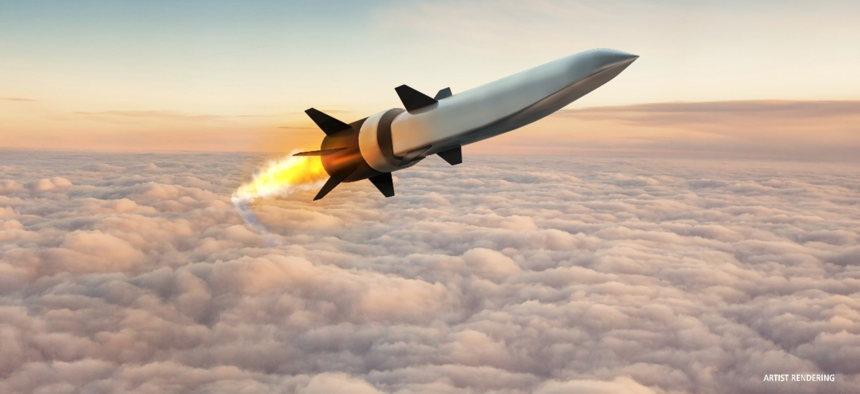
An artist rendering of the Hypersonic Air-breathing Weapon Concept (HAWC) DARPA
Collins Aerospace Creates Group to Make Hypersonic Weapons, Next-Generation Aircraft
The Advanced Structures unit will specialize in using composite materials to make lighter, more versatile systems.
Raytheon Technologies’ Collins Aerospace has quietly created a new business unit that executives say will allow the company to build critical parts for next-generation military aircraft and hypersonic weapons.
Called Advanced Structures, the group is reimagining the way aircraft and weapons are manufactured with new types of composite materials. The technology could make futuristic planes and missiles lighter and able to withstand extreme forces and temperatures, executives said.
“This isn't about company synergies or anything like that,” Samir Mehta, the group’s president, said in an interview. “This is really about taking the industrial capability that exists in one part of the organization, some of the enabling technologies that exist in another part of the organization, and putting them together to help change and to help grow what our aerostructures business can do.”
Collins—one of Raytheon’s four business units—created the group late last year, but has not publicized the move. Advanced Structures combines two of Collins business units, Mechanical Systems and Aerostructures. The mechanical systems group builds aircraft parts, including landing gear, wheels and brakes, and propellers, while the Aerostructures group has historically built nacelles, the casing wrapped around a plane’s engine.
“We realized that if we take some of the technologies that we have, and we apply them to some of these aerostructure-type projects and initiatives that we have, we might, and we think we do have some game-changing technologies,” Mehta said.
While the Advanced Structures business is largely focused on commercial projects, “the real massive growth prospect here really is on the defense side,” he said.
Mehta touted technologies, such as carbon-carbon, a material that the company uses in making brakes that can also be used to make an aircraft structure withstand high-speed flight.
“One of the challenges in hypersonics is you have to protect the payload in the most extreme environment,” Mehta said. “You think about the friction, you think about some of the heat characteristics and requirements, that a hypersonic, whether it's a projectile or whether it's an aircraft. This is the type of material that helps solve that particular problem.”
Hypersonic weapons can fly faster than five times the speed of sound, while also being able to maneuver, making it difficult to intercept. Raytheon’s missile and defense business is working on several hypersonic and counter-hypersonic weapon projects, part of a U.S. effort to catch up to weapons advances by China and Russia. Collins’ Advanced Structures business could become a supplier to Raytheon’s hypersonic efforts.
“We're basically taking the technology that we have in this Collins [business], and we're working closely with other parts of the company, including Raytheon Missiles and Defense, and being able to package up these technologies and provide the customer with a solution,” Mehta said.
Mehta said the technologies being developed by the Advanced Structures group will also allow the company to build next-generation aircraft with “conformal actuation.” Traditional aircraft wings have moving slats and flaps that control a plane’s direction, altitude, and speed. The new technology can allow the wing itself to change its shape, thus controlling the aircraft. Building an aircraft like this could help make it less detectable by radar, Mehta said.
The U.S. military is in the early stages of developing next-generation helicopters for the Army and combat fighters for the Air Force and Navy. The Collins’ reorganization could allow the Advanced Structures group to compete against companies that solely build aircraft structures.
“The advantage of working with someone like us, right, would be that we have a lot of these resident technologies under one roof,” Mehta said.




